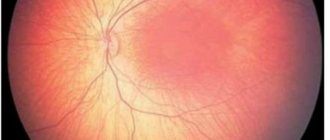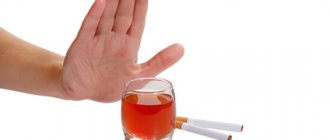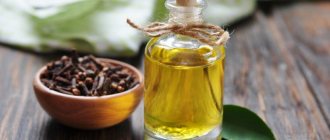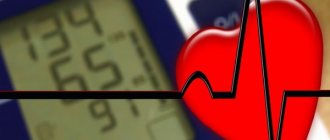Intraocular pressure (IOP) is an indicator of tone that forms between the fluid inside the eyeball and on the surface of the mucous membrane.
An average of about two cubic millimeters of fluid enters the human eye every minute , and if the same outflow is not ensured, high or low blood pressure is diagnosed .
Most often it is necessary to choose drops for eye pressure that will be effective and safe - this will be discussed below.
In addition, you can separately read articles on the topic of intraocular pressure:
- symptoms and causes;
- treatment with folk remedies.
List of eye pressure drops
Drops are often used to treat the described pathology and for preventive purposes. They differ radically in their composition and mechanism of action on the human visual apparatus.
Depending on which component is the main one, drops are usually divided into:
- Carbonic anhydrase inhibitors.
- Cholinomimetics.
- Beta blockers.
- Complex means of combined action.
- Sympathomimetics.
- Alpha adrenergic agonists.
- Prostaglandin analogues.
The choice of medications to restore vision by stabilizing intraocular pressure depends on the individual characteristics of the patient and the root cause that provoked the pathology. Some drugs ensure normal outflow of intraocular fluid, while others reduce its formation, while others belong to the combined complex group.
Benefits of inhibitors
This medication group is used for the development of glaucoma symptoms. The main action is aimed at the enzyme, which is produced in the ciliary body. When the function of the latter is impaired, the amount of moisture created decreases. To prevent such transformations, ophthalmologists often prescribe Trusopt and Azopt drops to patients. They differ in indications for use because they contain different active substances.
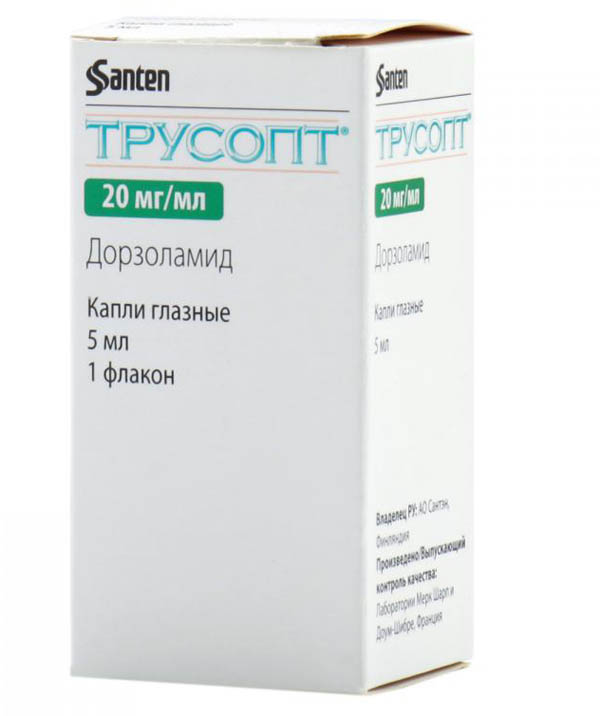
Azopt minimizes the movement of sodium and fluid, resulting in reduced moisture production within the visual system. As a result, normalization of pressure is observed. Azopt is often prescribed to people diagnosed with open-angle glaucoma. Such drops should be used with caution in cases of closed glaucoma and chronic liver diseases. Contraindication: kidney pathologies.
Trusopt drops are characterized by a similar effect. Their active component, dorzolamide hydrochloride, effectively copes with high blood pressure, which progresses against the background of intraocular hypertension or glaucoma. The drug has virtually no contraindications, which explains its widespread use.
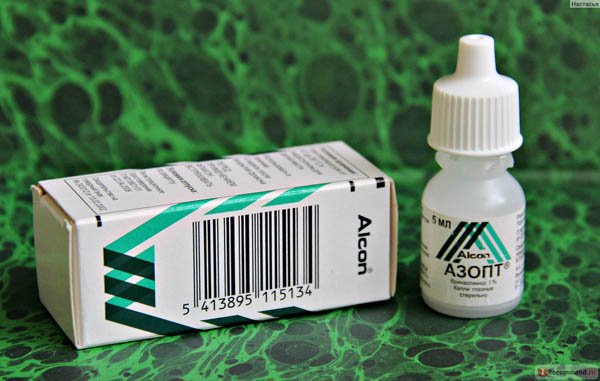
The benefits of cholinomimetics
To relieve intraocular pressure, the following drops of this group are used: Pilocarpine, Carbacholin. The main therapeutic focus of these drugs is to improve fluid outflow. Drops, which combine well with other medications, promote contraction of the intraocular muscles, narrow the pupil, which greatly facilitates the removal of moisture.
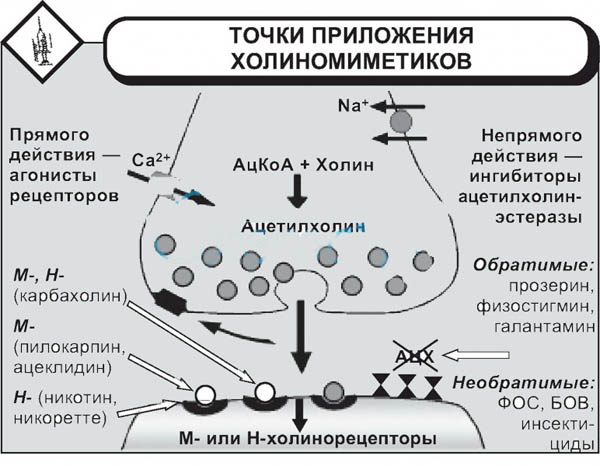
The drug Pilocarpine contracts the eye muscles by stimulating their receptors. Next, the pupil narrows, and the pressure decreases accordingly. Indications for use:
- Retinal vein thrombosis.
- Open-angle or closed-angle glaucoma.
- Preparing the patient for examination when it is necessary to constrict the pupil.
- Obstruction of the arteries in the retina.
- Elimination of overdose symptoms when using pupil dilators.
- The recovery period after surgery.
Cholinomimetics are not recommended for patients with allergic reactions to the components of the drops, keratitis, or iridocyclitis. Use is prohibited after surgery, when constriction of the pupil will lead to a serious deterioration of the condition.
In order to reduce pressure in the eyes, the drug Carbacholine is prescribed. It is intended for the safe treatment of patients diagnosed with angle-closure glaucoma. Contraindications include asthma, corneal disorders, allergic reactions, and angina.
Sedative drops
These components have a sedative effect and are used if blood pressure has increased due to the following conditions:
- neuroses;
- emotional instability;
- increased excitability;
- stress.
All these factors negatively affect the human body, causing an increase in blood pressure. Zelenin drops, due to their composition, help relieve these symptoms, stabilize the nervous system, normalize sleep and improve well-being. At the same time, blood pressure decreases.
To normalize high blood pressure caused by the above reasons, there is a remedy called VKPBP. Its name consists of the initial letters of its constituent components:
- valerian;
- chestnut;
- motherwort;
- hawthorn;
- peony.

This medicine is prepared from tinctures of these plants - you can buy them at the pharmacy, or you can prepare each one yourself and mix everything. This medicine has a sedative effect. It should be noted that chestnut thins the blood, so before starting therapy you need a doctor's advice.
Veropyrene drops
Veropiren drops have the following composition:
- Japanese Sophora;
- shiitake extract;
- astragalus extract;
- meadowsweet extract.
Thanks to this composition, veropiren is used for hypertension. It affects cholesterol levels, preventing the appearance of atherosclerosis, strengthens blood vessels and heart muscle, and helps reduce the risk of heart attack and stroke.
Benefits of sympathomimetics
This group of medications has a direct effect on receptors (at the cellular level). The drug Oftan Dipivefrin is widely used. The peculiarity of these drops is that the resulting liquid increases, after which its amount decreases, and the pupil dilates. The drug is indicated for open-angle glaucoma that forms after surgery (cataract). Contraindications: blockage of the angle of the anterior eye chamber, allergy to any of the components.
Benefits of prostaglandin analogues
This medication group is considered the most effective and safe. The therapeutic effect is observed after 1.5-2 hours after using these medications.
The most common ones are:
| A drug | About properties | About contraindications | About the testimony |
| Lanoprost | Under the influence of the medication, the outflow of fluid increases and intraocular pressure stabilizes. As a result of prolonged use, the shade of the eyes may change, as the number of pigment cells decreases. In most cases, there is brown pigmentation surrounding the pupil. | Childhood, history of inflammatory eye pathologies. | Open-angle glaucoma. |
| Taflotan | Effective relief of intraocular pressure. Restoration of metabolic processes in eye tissues. | Children's age, lactation period, pregnancy. | Open-angle glaucoma, high tone in the eyeball. |
| Unoprostone | The mechanism of action is due to the improvement of fluid outflow inside the eye. | Individual intolerance to any of the components of the drug. | Primary open-angle glaucoma, secondary glaucoma. |
| Travatan | The active substance is an analogue of prostaglandin 2F. Elimination of intraocular pressure, facilitating the outflow of moisture from the eye. | Allergies, childhood. Use with caution if there is acute iritis, damage to the lens capsule, or aphakia. | Open-angle glaucoma, extremely high intraocular pressure. |
| Trental | Microcirculation in the vessels is activated. | Hemorrhagic stroke, retinal hemorrhages. | Intraocular pressure. |
The dangers of high and low eye pressure
Increased intraocular pressure causes glaucoma. If it is not treated with drops that normalize ophthalmotonus, then death of the optic nerve may occur, which leads to blindness.
Low eye pressure over time can cause atrophy of the eyeball, its wrinkling. The regulatory functions of the vitreous body are disrupted, which leads to severe visual impairment.
You should regularly consult an ophthalmologist for preventive examinations. This will help to detect pathology in a timely manner and develop a set of measures necessary to preserve and restore vision.
The benefits of beta blockers
The action of such drugs is aimed at reducing the level of moisture produced. After instilling the eye drops, close them for a few minutes. During this time, beta blockers will have a local therapeutic effect, but will not have time to pass into the nasolacrimal ducts. If these conditions are not met, the drops will enter the circulatory system, which can negatively affect the functioning of the respiratory, endocrine, and cardiovascular systems.
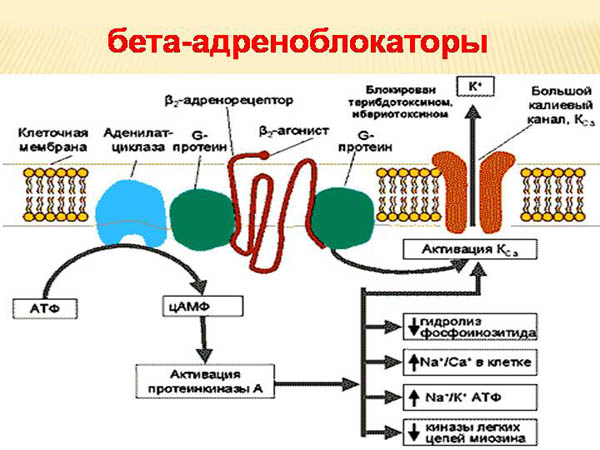
Modern antiglaucoma drops, tablets, and other forms of medications are practical to use and highly effective, as they cause almost no side effects. Among beta-blockers, drugs such as Timolol and Betoptik are often prescribed.
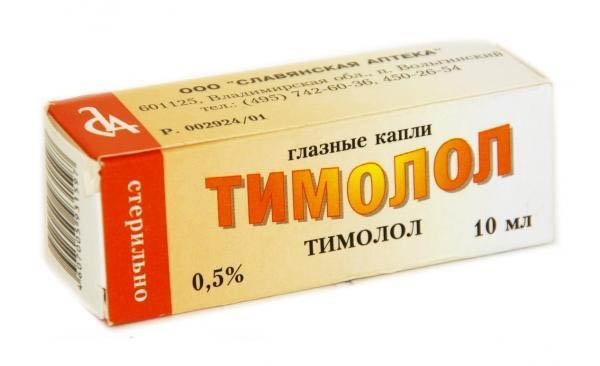
Timolol is well tolerated by patients in almost all cases; in exceptional cases, an increase in heart rate is noted. The action of these drops is aimed at preventing the formation of excess moisture and its unhindered outflow. Due to the fact that Timolol does not affect the pupil, there is no distortion of vision clarity. A drug is prescribed to stabilize pressure in the eyes of adults with primary (open-angle) and secondary glaucoma. Of the contraindications:
- Bradycardia.
- Childhood.
- Heart failure.
- Pathological processes occurring in the respiratory system and accompanied by obstruction.
- Dystrophic change in the structure of the cornea.
- If thyrotoxic goiter is diagnosed, the drug is used under the supervision of a specialist.
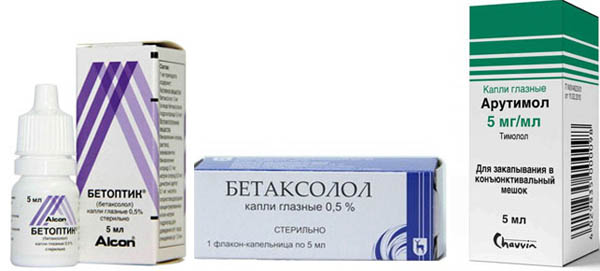
As for the drug Betoptik, its mechanism of action is almost similar to the previous description. If your eyes are swollen, ophthalmologists often prescribe such drops. They are distinguished by a selective effect on the cellular receptors of the eyes, which are responsible for the production of fluid in them. The active substance penetrates the cornea and can accumulate in soft tissues, resulting in side effects characteristic of beta blockers. Purpose: decreased tone in the eyeballs, open-angle glaucoma.
The benefits of alpha-agonists
If persistently high pressure inside the eyes is diagnosed, in some cases medications related to alpha-agonists are used. Their use is strictly limited as many patients experience adverse side effects. These drugs contain clonidine, a potent substance, they are prescribed if there are contraindications to beta-blockers, and if open-angle glaucoma is diagnosed. Contraindications: use of antidepressants, childhood.
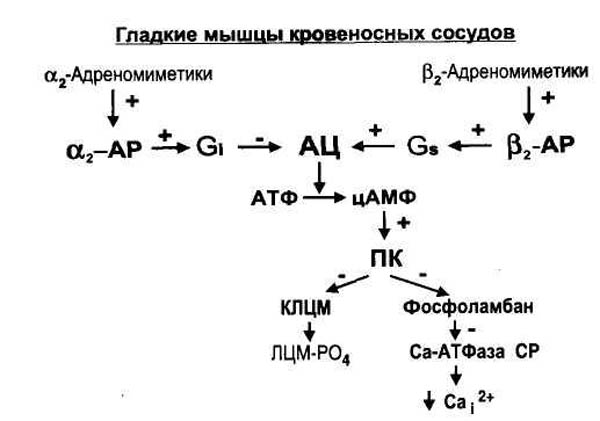
The benefits of combination medications
For the eyes, if high blood pressure is detected, combined action drops are often used. Such drugs usually contain several active substances at once, due to which a persistent hypotensive effect is achieved. The most common:
- Xalacom - a combination of Timolol with Xalatan, is prescribed in cases where other groups of medications have not had a positive effect in the treatment of glaucoma. These drops should not be used for pathologies of the heart, respiratory system, or children.
- Fotil - a combination of Timolol and Pilocarpine is used in ophthalmology to eliminate the symptoms of glaucoma. Contraindications include decreased heart rate, asthma, pathologies of the respiratory system, childhood, and recovery after surgery.
- Cosopt is a combination of Timolol and Trusopt. Drops are indicated for high eye pressure if a diagnosis of open-angle glaucoma is established. Contraindicated in pregnancy, under the age of 18 years, heart disease and respiratory system.
Contraindications and side effects
The use of drops that relieve high eye pressure should only be carried out as prescribed by an ophthalmologist. Since each product has its own composition and its own direction.
If the patient has a history of a corneal defect, an eye ulcer, a purulent inflammatory process in the organs of vision, herpes, fungi, ocular tuberculosis, diseases of the circulatory or cardiac system, renal failure, and in case of arterial crisis, taking such drops is prohibited. It is impossible to combine therapy with systematic antibiotics and medications containing sulfonamides; they cannot be combined with mydriatic and hematotoxic drugs. Use for adults only. Among the side effects, the most constant ones stand out: redness, itching, swelling, inflammation of the conjunctiva.
From traditional medicine
If the function of the visual apparatus is impaired, it is worth taking the advice of representatives of alternative medicine.
Herbal decoctions and infusions, honey will help eliminate the symptoms of a dangerous disease:
- The anti-inflammatory properties of natural honey are known. It should be diluted in warm water (proportion – 1:2), and swabs soaked in the solution should be applied to the eyes. Useful for conjunctivitis and early stages of cataracts.
- Freshly collected high-quality honey can be rubbed into the eyelids; a decoction of dandelions would be an excellent addition.
- Infuse about 25 grams of eyebright herb in 500 ml of boiling water. Soak cotton pads in the warm infusion and apply to the eyes. The course of treatment is long, after each month it is necessary to take a short break.
- Place dill seeds in cheesecloth and soak in boiling water for 5-7 minutes. Place the resulting warm bags over your eyes, preferably before bed.
- Lotions made from 1 teaspoon of lily of the valley and 100 g of nettle, which are brewed in 150 ml of boiling water, have proven effective.
- To wash the eyes, it is recommended to use a decoction of 4-5 aloe leaves and 250 ml of water. Repeat the procedure using a filtered decoction that has cooled to a comfortable state several times throughout the day.
- For any visual impairment, it is recommended to introduce carrots and blueberries into the diet.
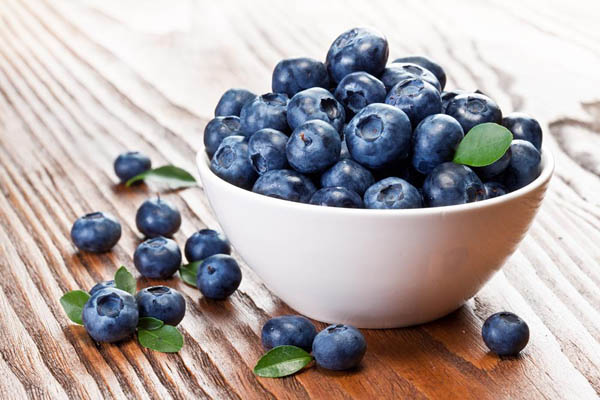
The use of various remedies at home should be discussed with your doctor. Self-medication can greatly harm your health and slow down the healing process.
